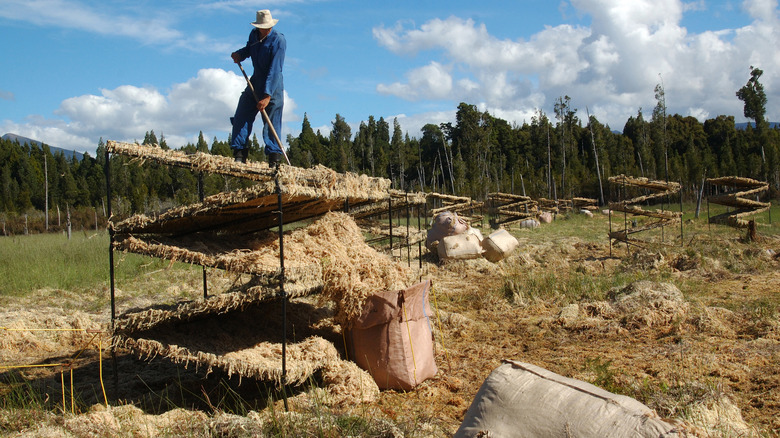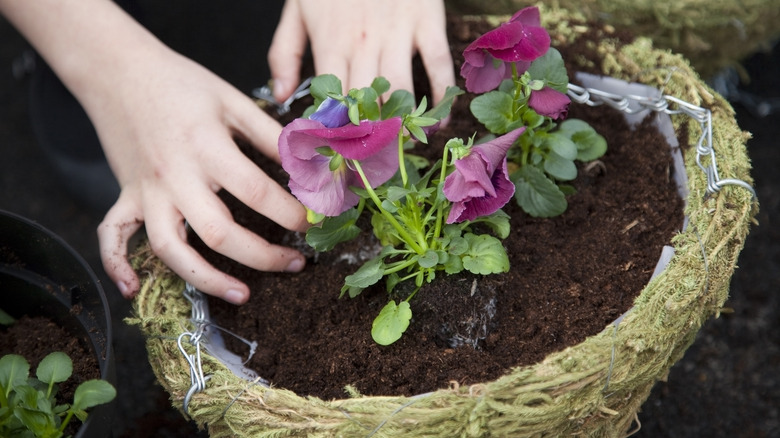You’ve done your research and picked out the best hanging plants for your outdoor space. Check! Step one toward achieving your overhead flower garden is done. Step two is assembling all those hanging baskets — namely, what you plan to line them with so all the soil doesn’t crumble away with every watering. One go-to option is a type of moss called sphagnum moss, an entire genus encompassing up to 300 species to date. It’s found in temperate regions worldwide and is typically wild-harvested from bogs. Peat moss, or bottom moss, a decaying layer underneath the growing top layer of sphagnum moss, is most often used in horticulture.
Gardeners covet it as a hanging basket liner because it keeps the soil moist while allowing for drainage, among other benefits. Like planters, hanging baskets dry out quickly — perhaps even more rapidly than their on-the-ground counterparts since they’re more exposed to drying elements like wind. Most plants you’d put in a hanging basket are heat-hardy, and they prefer fast-draining soil. Sphagnum moss retains water long enough that the plant’s roots have time for a good drink but not so long that the soil gets boggy. Also, though it’s an organic material, it takes a long time to decompose, meaning you’ll only have to replace it every two years or so. Despite moss — sphagnum moss, in particular — being the go-to medium for hanging baskets and one we recommend, there are a few downsides worth noting.
The mossy truth

Moss — sphagnum and peat — is considered a non-renewable resource, and it’s not always sourced sustainably. If you can’t be sure where and how a particular brand of moss was harvested, avoid buying it. Moss harvesting operations in the Pacific Northwest of the U.S.A. and Canada, the U.K. (specifically Wales and Scotland), Australia, and New Zealand are widely considered ecologically responsible. Sphagnum moss also has a low pH, which is great for acid-loving plants like violas or begonias but less so for those that prefer alkaline soils. If you don’t want to use sphagnum moss for any of these reasons, coconut coir (also called coco-fiber), burlap, compressed fiber (peat pots), or even an old wool sweater are suitable substitutes.
You could gather moss from your garden or neighborhood; it often grows in lawns. While some experts consider this a cost-saving idea, it’s also possible that the moss you harvest could harbor weed seeds, pests, or diseases. Adding it to your potted plants may introduce these unwanted (and often challenging to get rid of once established) nasties. Also, it isn’t easy to harvest moss sustainably. A patch of moss re-grows excruciatingly slowly — as little as one-quarter of an inch a year or up to twenty years if the moss is completely removed from an area. Collecting enough moss to fill a hanging planter risks harming the site’s biodiversity. It might even be illegal in some areas, like national parks, at least without first acquiring a permit.
Line your basket

Instead, buying quality sphagnum moss meant for hanging baskets from a trusted nursery or big box retailer is better. Sphagnum moss destined for use in home gardens and greenhouses must be treated for pests and diseases before it hits the market. Remember to look for sustainably harvested options, too — it might take a bit more digging, but it’s worth the hassle in greenie points. Pistils Nursery sells a one-quart bag of unprocessed Oregan sphagnum sourced ethically from Pacific Northwest forests for $10.00. Mosser Lee gets its dried long-fiber sphagnum moss from renewable locations in the U.S.A. Buy 432 cubic inches for $7.97 at Menards. If you need the basket with your moss, get this 12.5-inch-round, lined SuperMoss planter with chain from Amazon for $21.19.
Lining your hanging basket with sphagnum moss couldn’t be simpler. Press a one-inch layer of moss into the planter — it should stick out about an inch to four inches above the rim. Hold the basket above your head and scan for gaps (you’ll see a patch of light shining through), filling them with more moss as you go. If you want, add a plastic layer over the moss before filling the basket with compost or well-draining potting soil designed for hanging baskets. You’re done! Now, all that’s left is to fill it with your choice of drought-resistant flowers perfect for hanging baskets and find its ideal spot.



